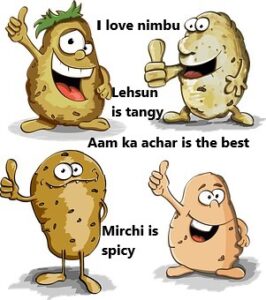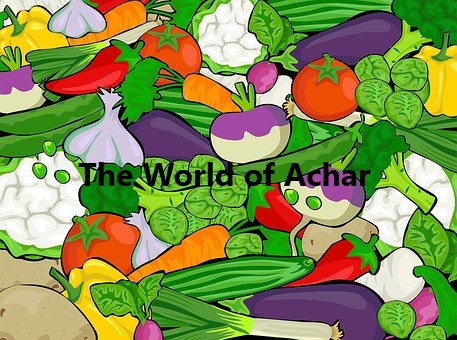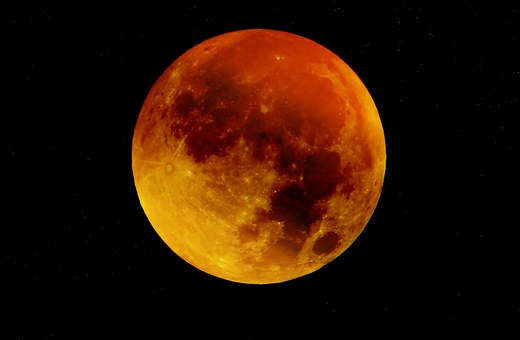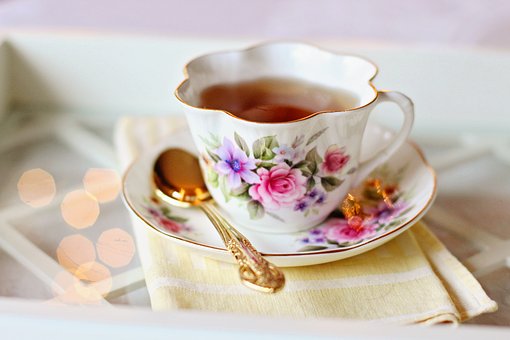Aam ka achar: Creating spiciness in our daily monotonous life

Today when my wife served me Lauki ki sabzi (a vegetable dish made out of bottle gourd), I couldn’t control my urge for an aam ka achar (mango pickle). Whenever there is a need to create some peppiness amongst our desi palate, achar(pickle) is the first thing that comes to mind. It is an accompaniment that has always remain understated in Indian cuisines. Its importance can be judged from the fact that its bottles occupy a permanent seat on the Indian dining table.
The various avatars of achars

Aloo or a gobhi ka paratha (vegetable stuffed flaky bread) is incomplete without an aam ka achar. Similarly, a Chola Bhatura (fried fermented bread) can be enjoyed with a hari mirch ka achar (green chilly pickle). There are times when the sabzi served along with rice is not of desired taste. As a result achar becomes a necessity. One can simply enjoy plain steamed rice mixing it with desi ghee and lal-mirch ka achar (red chili pickle).

There are various avatars of achar and each one of them has its own identity like Aam, Nimbu (lemon), Bhara Mirch, Leshun (garlic). On the other hand, there are few seasonal ones like Gobhi, Shaljam, Gajar, Mooli, and more. However, it is the aam ka achar that rules the throne when it comes to picking the best. Whether you go to a dhaba or a fine-dine restaurant, achar is an accompaniment that is served right at the beginning.
The Chemistry of achar
There is one thing unique about achar. The portion that mostly gets discarded in a ripe fruit or a vegetable is the one that becomes the most useful. An aam ka achar is relished more for its skin and similarly a nimbu or a lal-Mirch. All achars irrespective of their skin color are enjoyed by people of all races. There is no discrimination like brown, black, or white. In India achar of every color is enjoyed. A red-colored lal-mirch goes very well with a Chola bhatura. A dark brown nimbu achar is best enjoyed with curd rice. And green colored aam ka achar with a steaming hot aloo or gobhi ka paratha.

Every achar comes stuffed with a lot of spices that make it spicy, salty, and tangy. But despite being spicy and of different colors, people love achar. A combination of spiciness and color works well in achar, but the same can’t be said of humans, proving lethal. The unfortunate death of George Floyd in Minnesota, USA was all about discrimination on basis of color and a police force that was toxic.
Aam ka achar – the King of achars

When it comes to pickles, aam ka achar is always a preferred choice over others. Summer is the season when the king of fruits, mango is visible across every town in India. From the retail shelf of a departmental store to a vegetable cart, mangoes of different varieties are displayed in a pyramid format. The entire season lasts for 4-5 months and people relish the mango for its sweet juicy pulp. The skin of the mango and the seed pod is discarded. But the same skin that is discarded becomes the base of aam ka achar.
Raw mangoes with thick green skin are dried under the sun. Thereafter they are and blended with different spices and filled in a glass jar. The concoction of spices is prepared by the grandma. It’s a family recipe that has been and passed from generation to generation. The glass container is kept under the sun for at least 2 weeks. The vitamin D treatment helps the achar pick up its unique flavor, enhancing the taste of any dish it accompanies.
Achar a part of Indian tradition

Watch any television commercial of achar and you will see a grandma or a mother serving achar along with the Indian cuisine. The storyboard will show a grandmother mixing the spices and adding the cut pieces of the fruit/vegetable to it. The secret recipe that the grandmother learned from her mother has been passed on for generations. And the key to a tasty achar is the love that a grandmother pours into it. On the other hand, the spiciness of the achar is directly proportional to the chemistry between the mother-in-law and the daughter-in-law.
The Aam ka achar adding spice to your journey
One of the greatest places to see people enjoying achar is during a train journey. The moment it’s dinner time the entire AC coach is full of the smell of achar that makes your taste buds go hungry. A combination of poori and paratha with a sabzi and an aam ka achar is served on a paper plate. The moment you take the first bite while watching the passing electrical poles out of the window you feel like on a train to heaven.

People staying in the city of Delhi are used to having breakfast at a place called Murthal just on the outskirt. It’s a place made famous by a few dhabas (local eatery) serving stuffed parathas served with dollops of white butter and different kinds of achars. The popularity of the place can be guessed by seeing the number of cars parked on the premises.
Still savouring the taste
After licking the white butter from the fingers with the lingering taste of achar still in the mouth, people are tempted to buy various achars from the kiosks lining on the periphery of the dhabas. It’s difficult to pinpoint what has made these dhabas so popular? Is it the parathas, the butter, or the achars? But one thing is sure people who need a bit of spiciness in their life can’t stay away from achars.
Delhiites who want to spice up their night outing are familiar with night joints at Moolchand, AIIMS, Yousuf Sarai, Kamla market. All these joints are famous for serving a different kinds of parathas with lots of spicy achars. One can see people standing around a makeshift stall with steam vapours rising from a large iron tawa. The stall owner is busy pouring oil over the tawa, turning the parathas upside down to bake it from both sides. His assistant is busy serving the parathas with a spicy achar that is a mix of mirchi, gajar, and aam. The spicy achar definitely spruces ups a chilly winter night.
Enjoy reading more such stories on my blog. Click on the link below:
Indian Mithai: the sweets that sweeten our life
The Tea accompaniments and the romance with the tea
Learn more about the achar recipes by clicking on the following link:
https://www.tarladalal.com/recipes-for-pickles-achar-recipes-indian-pickle-recipes–246












Comments
6 Comments
The article has taken me back to the memory lane whe we use to run away the the pieces of mango kept for drying to make the achar.Feeling nostalgic.
Thanks for the feedback. Happy to know you liked it. And the cut pieces of mangoes were spread out on an old bedsheet under the sun.
Achar will never grow old . Now a days even some offers pizza with achari chicken or paneer. Achari mutton or chicken itself is alone a dish served in many restaurants and I love plain rice with achar and desi ghee even today so thanks for sharing so “addictive” subject
Even I also love the plain rice, desi ghee and lal mirch ka bharva achar.
[…] Aam ka achar: Creating spiciness in our daily monotonous life […]
[…] Aam ka achar: Creating spiciness in our daily monotonous life […]
Leave a Comment